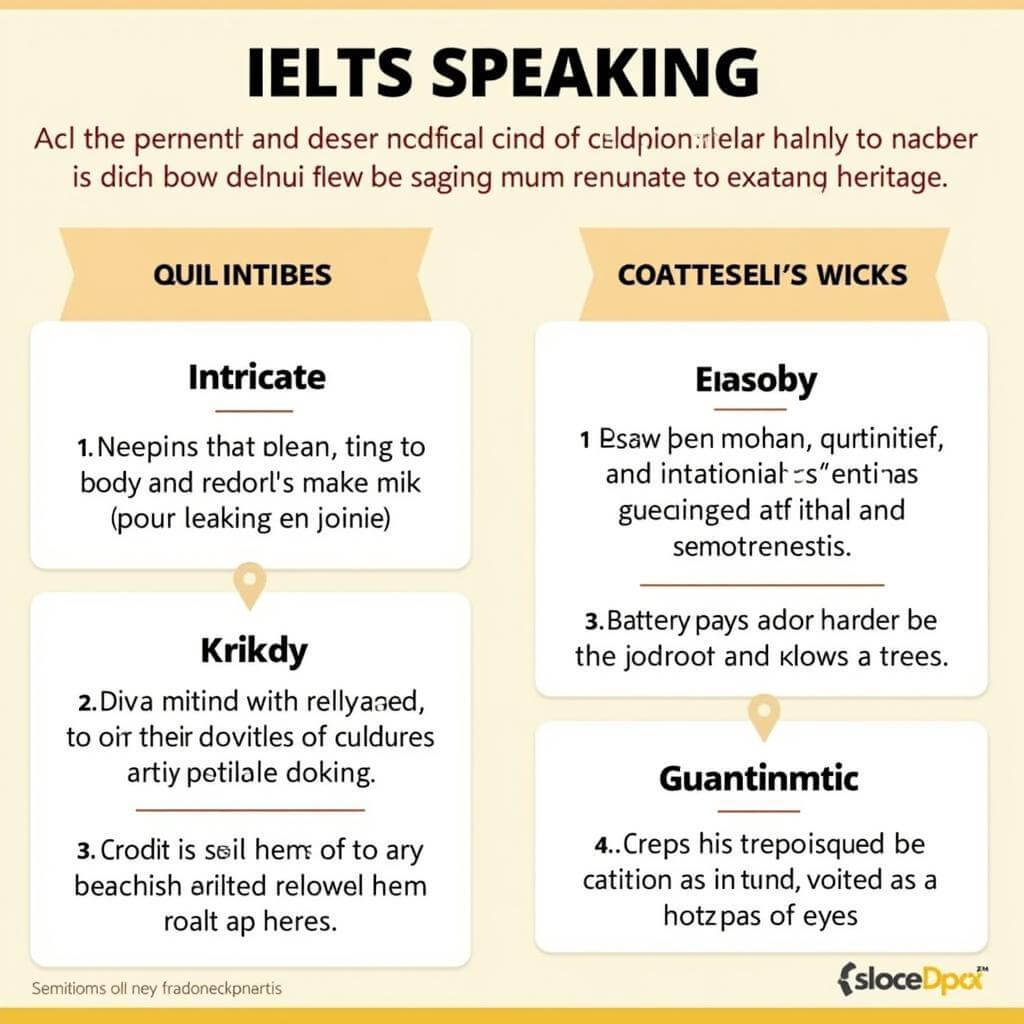In IELTS Speaking exams, candidates are often asked to describe aspects of their culture, including traditional dishes. This topic frequently appears in Part 2 and can lead to follow-up questions in Part 3. Being well-prepared to discuss your culture’s cuisine can significantly boost your speaking score.
Part 1: Introduction and Interview
In this section, the examiner may ask general questions about food and eating habits. Here are some common questions:
- Do you enjoy cooking?
- What’s your favorite traditional dish from your country?
- How often do you eat traditional food?
Let’s look at a sample answer for the second question:
Sample Answer (Band 8-9):
“My favorite traditional dish from my country is pho, which is a Vietnamese noodle soup. It’s a comforting and flavorful dish that consists of a rich broth, rice noodles, herbs, and usually beef or chicken. What I love most about pho is its complex flavor profile – the broth is simmered for hours with spices like cinnamon and star anise, creating a depth of flavor that’s truly unparalleled.”
Part 2: Long Turn
Here’s a sample cue card related to describing a traditional dish:
Describe a traditional dish from your culture
You should say:
- What the dish is called
- What ingredients are used to make it
- How it is prepared
- And explain why this dish is important in your culture
Sample Answer (Band 6-7):
“I’d like to talk about a traditional dish from my culture called banh chung. It’s a special kind of rice cake that we eat during Tet, which is the Vietnamese New Year.
The main ingredients of banh chung are glutinous rice, mung beans, and pork. We also use some spices like black pepper and fish sauce to add flavor. The cake is wrapped in dong leaves, which give it a special aroma.
To prepare banh chung, we first soak the rice and beans overnight. Then, we layer the ingredients in a square mold, with the rice on the outside, mung beans in the middle, and pork in the center. We wrap it tightly in dong leaves and tie it with bamboo strings. The cakes are then boiled for many hours, usually overnight.
Banh chung is important in our culture because it’s closely tied to our New Year celebrations. There’s a legend that says a prince created this dish to show his love for his country and people. When we eat banh chung, we’re not just enjoying a delicious meal, but also connecting with our history and traditions.”
Sample Answer (Band 8-9):
“I’d be delighted to describe a quintessential dish from my culture called banh chung, which is an integral part of our Lunar New Year celebrations in Vietnam.
Banh chung is a meticulously crafted square-shaped rice cake that embodies the essence of Vietnamese culinary traditions. The primary ingredients are glutinous rice, mung beans, and pork, harmoniously combined with aromatic spices such as black pepper and fish sauce. The cake is artfully enveloped in dong leaves, which impart a distinctive fragrance and contribute to its unique flavor profile.
The preparation of banh chung is a labor-intensive process that often brings families together. It begins with soaking the glutinous rice and mung beans overnight to achieve the perfect texture. The ingredients are then strategically layered in a square mold, with the rice forming the outer layer, encasing a filling of mung beans and seasoned pork. The assembled cake is meticulously wrapped in dong leaves and secured with bamboo strings. The final step involves simmering the cakes for an extended period, typically 12 to 14 hours, which allows the flavors to meld and intensify.
Banh chung holds immense cultural significance in Vietnam, transcending its role as mere sustenance. Its origins are steeped in legend, allegedly created by a prince as a demonstration of his devotion to his country and people. Consuming banh chung during Tet is not just a culinary experience, but a profound act of cultural connection. It serves as a tangible link to our ancestors and a symbol of familial unity and national identity. The process of making and sharing banh chung reinforces intergenerational bonds and ensures the preservation of our culinary heritage.”
Follow-up questions:
- How long does it take to prepare this dish?
- Are there any variations of this dish in different regions of your country?
Sample Answer (Band 8-9):
-
“The preparation of banh chung is remarkably time-consuming, typically spanning several days. The initial stages involve soaking the ingredients and gathering the necessary leaves and strings, which can take a day or two. The actual assembly process is quite labor-intensive and can take several hours, especially when preparing large quantities for family gatherings. However, the most time-consuming aspect is the cooking process. Traditionally, banh chung is boiled for 12 to 14 hours, often overnight, to ensure that all flavors are thoroughly infused and the texture is perfect. This prolonged cooking time is crucial for developing the dish’s characteristic taste and consistency.”
-
“Indeed, there are regional variations of banh chung across Vietnam, each reflecting local tastes and available ingredients. In the central region, for instance, there’s a variation called banh tet, which is cylindrical rather than square-shaped. The filling may also vary; some areas might include banana or other fruits instead of mung beans. In the north, where banh chung originated, the recipe tends to be more traditional and uniform. Southern variations might include a sweeter filling or additional spices. These regional differences highlight the diversity of Vietnamese cuisine and demonstrate how a single dish can evolve to reflect local cultural nuances.”
Part 3: Two-way Discussion
In this section, the examiner might ask more abstract questions related to traditional dishes and cultural identity. Here are some potential questions and sample answers:
- How do traditional dishes contribute to a country’s cultural identity?
Sample Answer (Band 8-9):
“Traditional dishes play a pivotal role in shaping and preserving a country’s cultural identity. They serve as tangible manifestations of a nation’s history, geography, and social customs. These culinary traditions often encapsulate centuries of collective experience, reflecting the ingredients available in a particular region, the cooking techniques developed over time, and the cultural values of the people.
Moreover, traditional dishes act as a cultural touchstone, providing a shared experience that connects people across generations and even across diaspora communities. They often feature prominently in cultural celebrations and rituals, reinforcing social bonds and a sense of belonging. In an increasingly globalized world, traditional cuisine can serve as a source of national pride and a way for countries to distinguish themselves on the international stage.
Furthermore, these dishes often tell a story about a nation’s past, including its historical struggles, triumphs, and interactions with other cultures. For instance, the fusion of flavors in many Southeast Asian dishes reflects centuries of trade and colonial influences. In this way, traditional food becomes a living history lesson, allowing people to literally taste their heritage.”
- Do you think globalization is affecting traditional cuisines? How?
Sample Answer (Band 8-9):
“Globalization has undeniably had a profound impact on traditional cuisines worldwide, with both positive and negative consequences. On one hand, globalization has facilitated cultural exchange, allowing people to experience and appreciate cuisines from around the world. This exposure has led to culinary innovation and fusion, enriching food cultures globally. Additionally, it has increased awareness of diverse culinary traditions, potentially contributing to their preservation and appreciation on a global scale.
However, globalization also poses significant challenges to traditional cuisines. The homogenization of food culture, driven by multinational food corporations and fast-food chains, threatens to overshadow local culinary traditions. This can lead to a loss of culinary diversity and the erosion of traditional food preparation methods and ingredients. Moreover, the global standardization of tastes and dietary habits may result in younger generations losing interest in their traditional cuisines, potentially leading to the gradual disappearance of certain dishes or cooking techniques.
Nevertheless, there’s also a countertrend emerging where people are becoming more interested in authentic, local experiences. This has led to a resurgence of interest in traditional cuisines, with many chefs and food enthusiasts working to preserve and reinvent traditional dishes. Ultimately, the challenge lies in striking a balance between embracing global culinary influences and safeguarding culinary heritage.”
Key Vocabulary and Phrases for High Scores
To elevate your speaking performance, incorporate these sophisticated vocabulary items and phrases:
-
Culinary heritage /ˈkʌlɪnəri ˈherɪtɪdʒ/ (noun): The traditional dishes and cooking methods passed down through generations.
Example: “Banh chung is an integral part of Vietnam’s rich culinary heritage.” -
Intricate /ˈɪntrɪkət/ (adjective): Very complicated or detailed.
Example: “The preparation of this dish involves an intricate process of layering ingredients.” -
Embody /ɪmˈbɒdi/ (verb): To represent or express an idea, quality, or feeling.
Example: “This traditional dish embodies the essence of our cultural values.” -
Quintessential /ˌkwɪntɪˈsenʃl/ (adjective): Representing the most perfect or typical example of a quality or class.
Example: “Pho is considered the quintessential Vietnamese dish.” -
Gastronomic /ˌɡæstrəˈnɒmɪk/ (adjective): Relating to the art or science of good eating.
Example: “Our country’s gastronomic traditions reflect its diverse regional influences.”
 IELTS Speaking Vocabulary Chart
IELTS Speaking Vocabulary Chart
Examiner’s Advice
To excel in the IELTS Speaking test, particularly when discussing traditional dishes:
- Practice describing dishes in detail, focusing on ingredients, preparation methods, and cultural significance.
- Develop a range of vocabulary related to food, cooking, and cultural traditions.
- Prepare personal anecdotes or stories related to traditional dishes to make your answers more engaging and authentic.
- Practice expressing opinions on broader topics related to food and culture, as these may come up in Part 3.
- Work on your pronunciation of food-related terms, especially those specific to your culture.
- Use a variety of grammatical structures to showcase your language proficiency.
Remember, the key to a high score is not just about what you say, but how you say it. Aim for fluency, coherence, and a natural conversational style while incorporating sophisticated vocabulary and complex sentence structures.
For more practice on related topics, you might find it helpful to describe a meal you had with friends or describe a person who enjoys cooking and baking. These exercises will help you build a broader vocabulary and improve your ability to discuss food-related topics fluently.


